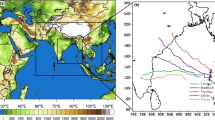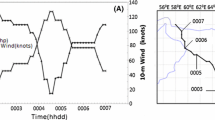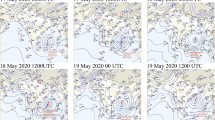Abstract
The predictability of Cyclone Sidr in the Bay of Bengal was explored in terms of track and intensity using the Advanced Research Hurricane Weather Research Forecast (AHW) model. This constitutes the first application of the AHW over an area that lies outside the region of the North Atlantic for which this model was developed and tested. Several experiments were conducted to understand the possible contributing factors that affected Sidr’s intensity and track simulation by varying the initial start time and domain size. Results show that Sidr’s track was strongly controlled by the synoptic flow at the 500-hPa level, seen especially due to the strong mid-latitude westerly over north-central India. A 96-h forecast produced westerly winds over north-central India at the 500-hPa level that were notably weaker; this likely caused the modeled cyclone track to drift from the observed actual track. Reducing the model domain size reduced model error in the synoptic-scale winds at 500 hPa and produced an improved cyclone track. Specifically, the cyclone track appeared to be sensitive to the upstream synoptic flow, and was, therefore, sensitive to the location of the western boundary of the domain. However, cyclone intensity remained largely unaffected by this synoptic wind error at the 500-hPa level. Comparison of the high resolution, moving nested domain with a single coarser resolution domain showed little difference in tracks, but resulted in significantly different intensities. Experiments on the domain size with regard to the total precipitation simulated by the model showed that precipitation patterns and 10-m surface winds were also different. This was mainly due to the mid-latitude westerly flow across the west side of the model domain. The analysis also suggested that the total precipitation pattern and track was unchanged when the domain was extended toward the east, north, and south. Furthermore, this highlights our conclusion that Sidr was influenced from the west side of the domain. The displacement error was significantly reduced after the domain size from the western model boundary was decreased. Study results demonstrate the capability and need of a high-resolution mesoscale modeling framework for simulating the complex interactions that contribute to the formation of tropical cyclones over the Bay of Bengal region.



















Similar content being viewed by others
References
Akter N, Tsuboki K (2010) Characteristics of supercells in the rainband of numerically simulated Cyclone Sidr. SOLA 6A:25–28
Badarinath KVS, Kharol SK, Sharma A, Ramaswamy V, Kaskaoutis DG, Kambezidis HD (2009) Investigations of an intense aerosol loading during 2007 cyclone SIDR—a study using satellite data and ground measurements over Indian region. Atmos Environ 43:3708–3716
Bessho K, DeMaria M, Knaff JA (2006) Tropical cyclone wind retrievals from the Advanced Microwave Sounder Unit (AMSU): application to surface wind analysis. J App Meteorol 45:399–415
Bhaskar Rao DV, Srinivas D (2010) Real-time prediction of SIDR Cyclone over Bay of Bengal using high-resolution mesoscale models. Indian Ocean Trop Cyclones Clim Chang 3:159–167. doi:10.1007/978-90-481-3109-9_20
Chen SS, Price JF, Zhao W, Donelan MA, Walsh EJ (2007) The CBLAST-Hurricane Program and the next-generation fully coupled atmosphere–wave–ocean models for hurricane research and prediction. Bull Am Meteorol Soc 88:311–317
Corbosiero KL, Molinari J, Vollaro D, Wang W, Done JM (2008) The distribution of helicity and intense convection in tropical cyclones. Paper P2F.13, 28th AMS Conference on hurricane and tropical meteorology, Orlando, 28 April–2 May 2008
Davis C, Wang W, Chen SS, Chen Y, Corbosiero K, DeMaria M, Dudhia J, Holland G, Klemp J, Michalakes J, Reeves H, Rotunno R, Snyder C, Xiao Q (2008) Prediction of landfalling hurricanes with the Advanced Hurricane WRF model. Mon Weather Rev 136:1990–2005
Denis B, Laprise R, Caya D (2003) Sensitivity of a regional climate model to the resolution of the lateral boundary conditions. Clim Dyn 20:107–126
Donelan MA, Haus BK, Reul N, Plant WJ, Stiassnie M, Graber HC, Brown OB, Saltzman ES (2004) On the limiting aerodynamic roughness of the ocean in very strong winds. Geophys Res Letts. doi:10.1029/2004GL019460
Dudhia J (1989) Numerical study of convection observed during the winter monsoon experiment using a mesoscale two-dimensional model. J Atmos Sci 46:3077–3107
Dudhia J, Done J, Wang W, Chen Y, Xiao Q, Davis C, Holland G, Rotunno R, Torn R (2008) Prediction of Atlantic tropical cyclones with the Advanced Hurricane WRF (AHW) model. 28th AMS Conference on hurricanes and tropical meteorology, Paper 18A2, Orlando, 28 April–2 May 2008. http://ams.confex.com/ams/28Hurricanes/techprogram/paper_138004.htm
Emanuel KA (1986) An air–sea interaction theory for tropical cyclones. Part I: steady-state maintenance. J Atmos Sci 43:585–604
Emanuel KA (1995) Sensitivity of tropical cyclones to surface exchange coefficients and a revised steady-state model incorporating eye dynamics. J Atmos Sci 52:3969–3976
Hong SY, Dudhia J, Chen SH (2004) A revised approach to ice microphysical processes for the bulk parameterization of clouds and precipitation. Mon Weather Rev 132:103–120
IMD (2008) Track of storm and depressions over the Indian Seas during 1891–2007, Cyclone e-Atlas of IMD. IMD, New Delhi
Knaff JA, DeMaria M (2006) A multi-platform satellite tropical cyclone wind analysis system. http://rammb.cira.colostate.edu/products/tc_realtime/images/MPSW.pdf
Kotal SD, Roy Bhowmik SK, Kundu PK (2008) Application of statistical–dynamical scheme for real time forecasting of the Bay of Bengal very severe cyclonic storm “Sidr” of November 2007. Geofizika 25:139–158
Mlawer EJ, Taubman SJ, Brown PD, Iacono MJ, Clough SA (1997) Radiative transfer for inhomogeneous atmosphere: RRTM, a validated correlated-k model for the long-wave. J Geophys Res 102:16663–16682
Mueller KJ, DeMaria M, Knaff JA, Vonder Haar TH (2006) Objective estimation of tropical cyclone wind structure from infrared satellite data. Weather Forecast 21:990–1005
Noh Y, Cheon WG, Hong SY, Raasch S (2003) Improvement of the k-profile model for the planetary boundary layer based on large eddy simulation data. Bound Layer Meteorol 107:401–427
Pattanayak S, Mohanty UC (2008) A comparative study on performance of MM5 and WRF models in simulation of tropical cyclones over Indian seas. Curr Sci 95:7
Paul B (2010) Human injuries caused by Bangladesh’s Cyclone Sidr: an empirical study. Nat Hazards 54:483–495
Pollard RT, Rhines PB, Thompson RORY (1973) The deepening of the wind mixed layer. Geophys Fluid Dyn 4:381–404
Rao R, Molinari RL, Festa JF (1989) Evolution of the climatological near-surface thermal structure of the tropical Indian Ocean. J Geophys Res 94:1081–10815
Rosenthal SL (1971) The response of a tropical cyclone model to variations in boundary layer parameters, initial conditions, lateral boundary conditions and domain size. Mon Weather Rev 99:767–777
Xiao Q, Zhang X, Davis C, Tuttle J, Holland G et al (2009) Experiments of hurricane initialization with airborne Doppler radar data for the Advanced-research Hurricane WRF (AHW) model. Mon Weather Rev. doi:10.1175/2009MWR2828.1
Acknowledgments
The authors would like to thank Qingnong Xiao from MMM Division at National Center for Atmospheric Research (NCAR) for the internal review on an initial draft. We also thank NCAR supercomputing resources for providing computing GAUS. NCAR is sponsored by the National Science Foundation. The study also benefited from the NSF CAREER grant (ATM-0847472).
Author information
Authors and Affiliations
Corresponding author
Additional information
Responsible editor: C. Simmer.
Rights and permissions
About this article
Cite this article
Kumar, A., Done, J., Dudhia, J. et al. Simulations of Cyclone Sidr in the Bay of Bengal with a high-resolution model: sensitivity to large-scale boundary forcing. Meteorol Atmos Phys 114, 123 (2011). https://doi.org/10.1007/s00703-011-0161-9
Received:
Accepted:
Published:
DOI: https://doi.org/10.1007/s00703-011-0161-9




